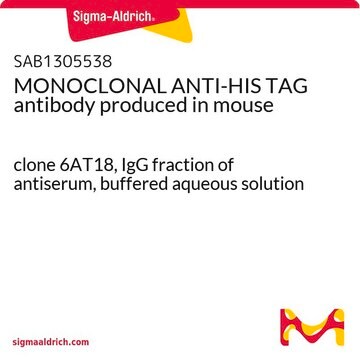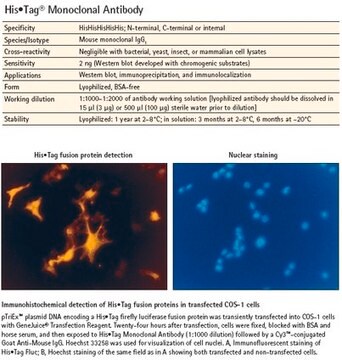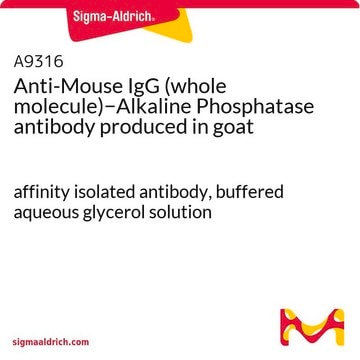A5588
Monoklonaler Anti-Polyhistidin−alkalischer Phosphatase-Antikörper der Maus
clone HIS-1, purified from hybridoma cell culture
Synonym(e):
Monoklonaler Anti-polyhistidin-Antikörper, Monoklonale Anti-polyhistidin−alkalische Phosphatase in Maus hergestellte Antikörper, Monoklonales 6-His-Epitop-Tag, Monoklonales 6xHis-Tag, Monoklonales HHHHHH-Epitop-Tag, Monoklonales Hexahistidin-Tag, Monoklonales His-Tag, Monoklonales His6-Tag, Monoklonales Histidin-Tag, Monoklonales Polyhistidin-Tag
About This Item
Empfohlene Produkte
Biologische Quelle
mouse
Konjugat
alkaline phosphatase conjugate
Antikörperform
purified from hybridoma cell culture
Antikörper-Produkttyp
primary antibodies
Klon
HIS-1, monoclonal
Form
buffered aqueous glycerol solution
Methode(n)
western blot: 1:2,000 using lysates of Escherichia coli induced to express a 6xHis tagged protein
Isotyp
IgG2a
Versandbedingung
wet ice
Lagertemp.
2-8°C
Suchen Sie nach ähnlichen Produkten? Aufrufen Leitfaden zum Produktvergleich
Allgemeine Beschreibung
Spezifität
Immunogen
Anwendung
Physikalische Form
Rechtliche Hinweise
Not finding the right product?
Try our Produkt-Auswahlhilfe.
Lagerklassenschlüssel
10 - Combustible liquids
WGK
WGK 3
Flammpunkt (°F)
Not applicable
Flammpunkt (°C)
Not applicable
Persönliche Schutzausrüstung
Eyeshields, Gloves, multi-purpose combination respirator cartridge (US)
Analysenzertifikate (COA)
Suchen Sie nach Analysenzertifikate (COA), indem Sie die Lot-/Chargennummer des Produkts eingeben. Lot- und Chargennummern sind auf dem Produktetikett hinter den Wörtern ‘Lot’ oder ‘Batch’ (Lot oder Charge) zu finden.
Besitzen Sie dieses Produkt bereits?
In der Dokumentenbibliothek finden Sie die Dokumentation zu den Produkten, die Sie kürzlich erworben haben.
Kunden haben sich ebenfalls angesehen
Unser Team von Wissenschaftlern verfügt über Erfahrung in allen Forschungsbereichen einschließlich Life Science, Materialwissenschaften, chemischer Synthese, Chromatographie, Analytik und vielen mehr..
Setzen Sie sich mit dem technischen Dienst in Verbindung.













